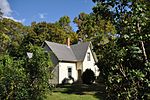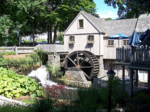Billington Sea
Neighborhoods in Plymouth, MassachusettsPonds of MassachusettsPonds of Plymouth, Massachusetts

Billington Sea (also Billington's Sea) is a 269-acre (1.09 km2) warm water pond located in Plymouth, Massachusetts. Morton Park lies on the pond's northern shore. The pond is fed by groundwater and cranberry bog outlets. The average depth is seven feet and the maximum depth is 11 feet (3.4 m). The pond provides the headwaters to Town Brook. Seymour Island is located in the center of the pond. Billington Sea was named after its discoverer, Francis Billington, one of the passengers on the Mayflower.
Excerpt from the Wikipedia article Billington Sea (License: CC BY-SA 3.0, Authors, Images).Billington Sea
Morton Park Road, Plymouth
Geographical coordinates (GPS) Address Nearby Places Show on map
Geographical coordinates (GPS)
| Latitude | Longitude |
|---|---|
| N 41.941666666667 ° | E -70.676666666667 ° |
Address
Morton Park Road
Morton Park Road
02360 Plymouth
Massachusetts, United States
Open on Google Maps






